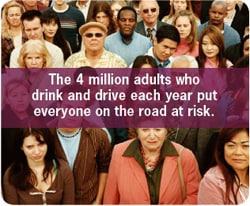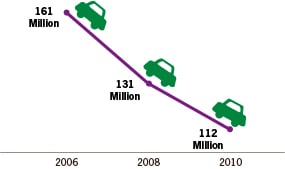Drinking and driving: there are stupider things, but it’s a very short list. ~Author is unknown. This quote is dripping with the blood of Americans. In 2015, 10,265 people died in drunk driving crashes- one every 51 minutes-and 290,000 were injured in drunk driving crashes1 . The average drunk driver has driven drunk over 80 times before their first arrest according to Mothers Against Drunk Driving (MADD).
Jay Harold as a teenager saw a good friend and mentor killed because of the actions of a drunk driver. Drunk driving has been and is a serious public health concern.
Jay Harold used data from The Centers for Disease Control and Prevention (CDC) to provide information about drinking and driving2 .
People who drink and drive put everyone on the road in danger
Your best defense against a drunk driver is to buckle up every time.
- Every person in every seat should be buckled up on every trip. Seat belts reduce serious injuries and deaths from crashes by about 50%.
- Primary enforcement seat belt laws allow police to stop vehicles just because someone is not wearing a seat belt. These state laws are effective in increasing seat belt use.
Certain groups are more likely to drink and drive than others.
- Men were responsible for 4 in 5 episodes (81%) of drinking and driving in 2010.
- Young men ages 21-34 made up only 11% of the U.S. adult population in 2010, yet were responsible for 32% of all instances of drinking and driving.
- 85% of drinking and driving episodes were reported by people who also reported binge drinking. Binge drinking means 5 or more drinks for men or 4 or more drinks for women during a short period of time.
There are proven ways to prevent people from drinking and driving.
- At sobriety checkpoints, police stop drivers to judge if they are driving under the influence of alcohol. More widespread, frequent use of these checkpoints could save about 1,500 to 3,000 lives on the road each year.
- Minimum legal drinking age laws prohibit selling alcohol to people under 21 years old in all 50 states and the District of Columbia. Keeping and enforcing 21 as the minimum legal drinking age helps keep young, inexperienced drivers from drinking and driving.
- Ignition interlocks prevent drivers who were convicted of alcohol-impaired driving from operating their vehicles if they have been drinking. Interlocks are effective in reducing re-arrest rates from drinking and driving by about two-thirds while the device is on the vehicle.

SOURCE: CDC Behavioral Risk Factor Surveillance System, US 2010
Drinking and driving episodes by gender and age, 2010

SOURCE: CDC Behavioral Risk Factor Surveillance System, US 2010
Some likely effects on driving

Adapted from The ABCs of BAC, National Highway Traffic Safety Administration, 2005, and How to Control Your Drinking, WR Miller and RF Munoz, University of New Mexico, 1982.
Self-reported annual drinking and driving episodes

SOURCE: CDC Behavioral Risk Factor Surveillance System, US 2006, 2008 and 2010
What Can Be Done
States can

Young men ages 21-34 made up only 11% of the U.S. adult population in 2010, yet were responsible for 32% of all instances of drinking and driving.
- Enforce 0.08% blood alcohol concentration and minimum legal drinking age laws.
- Expand the use of sobriety checkpoints.
- Require ignition interlocks for everyone convicted of drinking and driving, starting with their first offense.
- Consider including strategies to reduce binge drinking—such as increasing alcohol taxes—to reduce drinking and driving, since the two behaviors are linked.
- Pass primary enforcement seat belt laws that cover everyone in the car.
Employers can
- Set policies that immediately take away all work-related driving privileges for any employee cited for drinking and driving while using a company or personal vehicle for work purposes.
- Use workplace health promotion programs to communicate the dangers of drinking and driving, including information directed to family members.
Health professionals can
- Help patients realize that car crashes are the leading cause of death for everyone ages 5-34 and that 1 in 3 crash deaths involves a drunk driver.
- Routinely screen patients for risky drinking patterns, including binge drinking, and provide a brief intervention—a 10–15-minute counseling session—for patients who screen positive.
Everyone can
- Choose not to drink and drive and help others do the same.
- Before drinking, designate a nondrinking driver when with a group.
- If out drinking, get a ride home or call a taxi.
- Don’t let friends drink and drive.
- Choose not to binge drink themselves and help others not to do it.
- Talk with a doctor or nurse about drinking and driving and request counseling if drinking is causing health, work, or social problems.
- Buckle up every time, no matter how short the trip. Encourage passengers in the car to buckle up, including those in the back seat.
In 2014, over 1.1 million drivers were arrested for driving under the influence of alcohol or narcotics3 . The personal cost in legal fees, possible lawsuits and injuries are very high.
Enjoyed this post? Share it and read more here. Questions? “Ask the Pharmacist a Question!” Jay Harold is always looking out for your health and wealth.
Bibliography
- http://www.madd.org/drunk-driving/about/drunk-driving-statistics.html
- http://www.cdc.gov/vitalsigns/drinkinganddriving/index.html
- http://www.cdc.gov/motorvehiclesafety/impaired_driving/impaired-drv_factsheet.html





